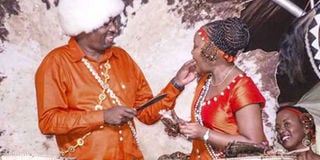Emulate The Kamothos, embrace culture

Kamotho Waiganjo and Anne Waiguru share a piece of meat during their traditional wedding ceremony on July 13, 2019 at Kiamugumo Primary School in Gichugu, Kirinyaga County. PHOTO | COURTESY
What you need to know:
- Culture forms the basis of our identity.
- Ngurario is the final part of the Kikuyu wedding rites that completes and formalises the marriage.
Kirinyaga Governor Anne Mumbi and lawyer Kamotho Waiganjo’s recent wedding in their home county drew its unique and grand attributes from its primary and superior embrace of the Kikuyu culture.
Performing the rites of a Kikuyu wedding is not new. However, the fact that an influential couple, known for their independent contribution to governance and national development, would chose to have a traditional wedding gave it the pre-eminence it deserved.
Culture forms the basis of our identity. Everything we do references our upbringing, to which culture is central. What happens before the actual wedding day, brings the community together and re-emphasises our irrefutable connectedness to it.
WEDDING RITES
Ngurario is the final part of the Kikuyu wedding rites that completes and formalises the marriage. The preceding rites include kumenya mucii, which is visiting the bride’s home, kuhanda ithigi (planting of branches, or marking territory), itara (a visit by the bride’s family to the groom’s home) and kuracia, the paying of dowry.
On the day of ngurario, the family of the groom arrives at the home of the bride. They knock at the gate or door to be let in. They come bearing gifts and wares — in the form of food, clothing, implements and utensils.
They are expected, even required, to pay a fee for wauri, which is “lifting the burden” of the goods on their backs.
After they have been welcomed and received, the groom is expected to “gucagura muka wake”, which is to identify his bride from among other women whose identity is deliberately concealed. Should he fail to do so, or select the wrong lady, a fine is levied on him for the error.
Before embarking on the next part of the ceremony, the bride and groom adorn themselves in Kikuyu traditional attire.
SOLEMN OCCASION
The ngurario ceremony is a solemn occasion that is conducted by a Kikuyu elder. The ceremony involves gutinia kiande kana guoko, which is cutting the shoulder, or “arm” (a goat’s right front leg), gitungo kia mara (intestines), ikengeto (ears) and higo (kidneys).
Each of these parts represents important aspects of the married life. For example, the man feeds the goat’s ears to his new wife to symbolise her attentive listening to his word.
The couple, and their respective families, then make a public declaration that they belong to one another. Among the Kikuyu, this rite is complete and final and no other is required or expected to achieve the same outcome.
I am thankful to The Kamothos for leading the way towards renewed awareness of our cultures.
CULTURAL CENTRES
I am encouraged and support the initiative and directive by President Uhuru Kenyatta, who graced the occasion, to establish cultural centres in the counties to revive and preserve our national heritage, which is drawn from our diverse traditions, cultures, and history.
In appreciation to our tapestry of traditions, we must go back to recapture and recover our lost knowledge, wisdom and wealth. We must embrace its anchoring obligations and responsibilities, for this will surely enhance our national well-being.
Mr Gikonyo is a business consultant and communications specialist. [email protected].




